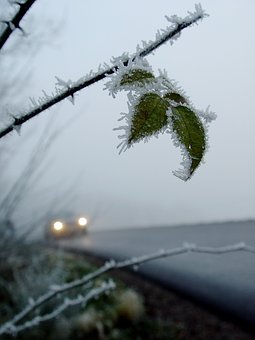
By USAG Bavaria Public Affairs
Winter driving isn’t only about dealing with snow. Ice on the road is a real threat.
Black ice, in particular, is dangerous because it’s invisible (the term “black ice” being somewhat of a misnomer). However, you can better protect yourself by understanding and knowing how to deal with this winter issue.
1. Understand that black ice is like regular ice.
Black ice is a glaze that forms on surfaces (especially roads, sidewalks, and driveways) because of a light freezing rain, fog or because of melting and re-freezing of snow, water, or ice on surfaces. It’s called “black ice” because it tends to look like the rest of the pavement on the road, although in reality, it’s actually clear.
Black ice forms without creating bubbles, which allows it to blend in with any surface it forms over. Black ice is dangerous because it’s very difficult to detect in advance. Being aware and adjusting your speed and driving behavior can reduce the risk of being involved in a serious accident due to black ice.
2. Know where to expect black ice.
Black ice usually forms just about the freezing point, though not all inclusive here are some area’s to consider. Sometimes in frigid weather conditions on highways, black ice will form due to the heat of tires on the road coupled with the freezing temperature. Keep an eye on the weather and highway reports.
- Black ice forms most commonly at night or in the early morning when the temperatures are at their lowest, or when the sun isn’t around to warm the roads.
- Black ice tends to form on parts of the road without much sunshine, such as along a tree-lined route or a tunnel and overpasses. Black Ice may also form more frequently on roads that are less traveled on.
- Black ice forms readily on bridges, overpasses and the road beneath overpasses. This is due to cold air being able to cool both the top and underside of the bridge or overpass, causi9ng the surface to freeze faster.
3. Know when to expect black ice.
Black ice tends to form in the early morning and evening. During the daylight hours, the road is usually warmer and less likely to create black ice. But remember: less likely does not mean “never”. Always be prepared for the possibility of encountering black ice.
- See the signs of black ice. If you are driving and see cars suddenly swerve for no apparent reason, black ice could have been the cause.
4. Know how to see black ice – sometimes.
While black ice is transparent, it can sometimes be seen in the right lighting conditions — if you are looking for it.
Black ice almost always forms in very smooth, very glossy sheets. This glossy surface is your indication of potential black ice. If the majority of the road you’re driving on appears a dull black color, but the patch just ahead of you appears shiny, you may be about to drive onto black ice. Don’t panic. Follow the instructions below.
- This technique for helping to detect black ice doesn’t work well at night, but dawn, daylight and dusk should offer enough light to see.
- If you are unfamiliar with this glossy appearance, think of a nice new car’s black spray paint compared to an older, un-kept car’s black paint job.
- You won’t always be able to see black ice, but looking for it can’t hurt. It may also help you to stay focused in less than ideal driving conditions. Just be sure to keep your eyes on the rest of your environment as well.
5. Prevent or minimize future encounters with black ice.
Here are a few additional tips to remember during times of increased potential for black ice. While knowing how to drive on it remains a number one priority, here are some other things to do:
- Travel slowly. You may need to not drive the posted speed limit during icy weather, drive for the conditions of the road as this will take away any control you might have had on the black ice.
- Don’t tailgate.
- Keep your windshield clear of ice, snow, dirt, and anything else that can prevent you from seeing out of it properly. To get snow and ice off the windshield of your car. Use an ice scraper to scrape the ice from the windshield of your car before starting the vehicle.
- Turn your headlights on early in the afternoon to help you see any possible sheen from black ice.
- Check your tire tread. Worn tread causes accidents in any conditions, and will ensure you lack traction when needed on black ice. In addition, consider having snow tires fitted.
- An important thing to remember is not to drive in potentially icy conditions with your cruise control on.
- Be extra careful and slow down at on / off ramps of highways and priority roads, the curving direction of the ramps coupled with the weight of the vehicle and potential ice can cause the vehicle to loose traction.
